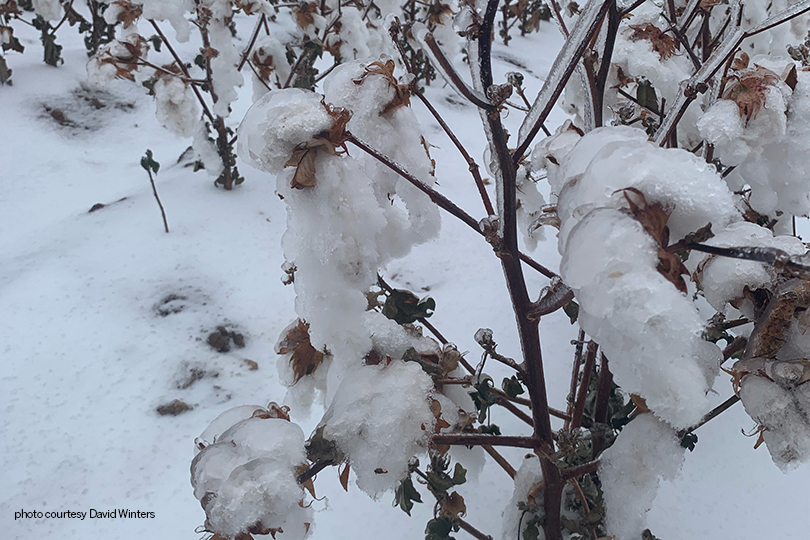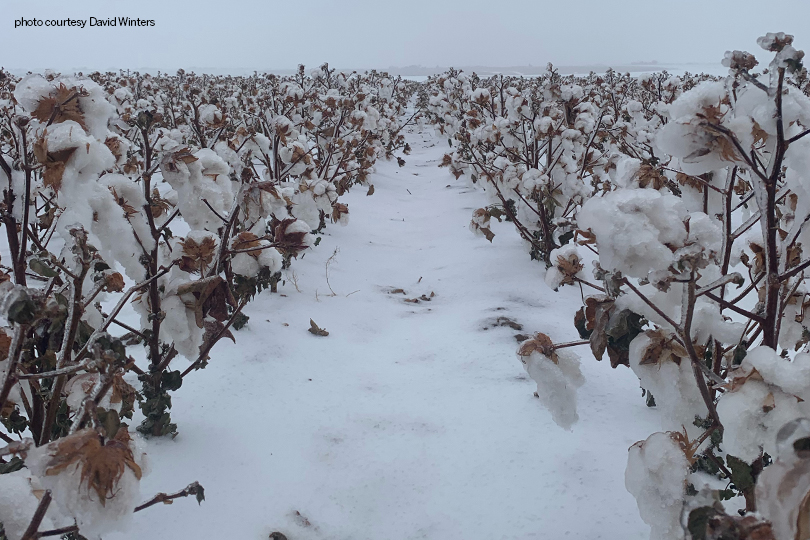By Jennifer Dorsett
Field Editor
Winter storms blanketed areas of Texas, including the Panhandle, High Plains, South Plains, Far West Texas and Cross Timbers/North Texas regions this week. They brought freezing rain, leading to heavy ice accumulation on buildings, trees and crops.
Farmers across the area scrambled to harvest what they could ahead of the storm, and ranchers cared for their cattle to ensure they had adequate forage and water.
Alan West, Lubbock County
Many South Plains residents were left without electricity after heavy ice brought down power lines across the area. But Lubbock County Farm Bureau (CFB) President Alan West said people were grateful the winds, while fierce at times, didn’t get any stronger.
“So far, there hasn’t been any serious wind, but there are lots of downed power lines and tree limbs and things like that,” West said. “We hadn’t had a freeze yet until now, so we still have lots of trees with foliage on them and the ice and the moisture just really was heavy and caused a lot of damage. But we’re lucky the winds weren’t worse and caused more damage.”
Just days earlier, the area had seen record high temperatures.
“We pretty much just went from record highs in the 90s to a severe cold snap in a matter of days,” West said. “We hope there’s not any damage to the crops that are still in the field, because it’s basically just put harvest at a standstill. I haven’t seen any lint on the ground or anything like that, so as long as we can avoid a significant wind event, we should get back to (harvest) shortly.”
David Winters, Randall County
From his farm south of Amarillo, David Winters said the storm could’ve been worse in terms of damages to the area’s cotton crops. He noted wet snow or driving rain combined with higher winds would have pulled the cotton out of the boll, significantly degrading the fiber quality.
Cotton harvest season was just getting underway for Randall County farmers, so the gin had already transported what modules were in the field to the gin yard.
“We’re roughly halfway done with cotton harvest. Our yields were a little off, but grades were phenomenal, with some of the highest we’ve had in the last two years,” Winters, a Randall CFB board member, said. “With this moisture, the grade may go down a little bit, but the cotton is frozen to the plant and covered by a layer of ice, so it’s not as bad as it could have been.”
The storm will benefit winter wheat crops, however.
“As far as our winter wheat seeding, this wet weather is a good thing. We planted the wheat in dry dirt, and we were waiting on precipitation to bring it up,” Winters said. “We were irrigating wheat until a week ago, which is really unheard of this late in the fall, but the crop just needed more water than what we could put on it. Our [potential-to-emit] PTE levels have been so high this fall that it’s been really hard to get winter wheat to grow like it should.”
He has calves ready to turn out for grazing as soon as the ice melts, and the moisture will be beneficial for those pastures.
The winter storm was the latest weather event in a year full of surprises.
“We’ve had such a roller coaster year. A week ago, it was 92 degrees, and now the highs are in the low 30s,” Winters said. “2020 just won’t stop.”
Russell Williams, Hartley County
Outside of Dalhart, Russell Williams was on the third day in a row of below-freezing temperatures.
“I lost all my cotton in Hartley County in June, but I still had some corn here that was getting near harvest,” Williams said. “It’s a good late corn crop I planted behind some hailed-out cotton, so it was still alive and green when the storm hit.”
The corn crop will likely yield 5-10 percent less now, because it won’t reach its full potential after being exposed to the cold for so long, he said.
Williams’ main concern right now is that the plants will be brittle after freezing and could easily snap if the area sees any high winds.
But next week’s forecast looks favorable, and he hopes his corn crop will dry out enough to begin harvest next week. Then, he plans to finish harvesting his cotton in Bailey County.
“I managed to grow two circles of cotton in Bailey County this year. I had harvested one circle there, and I have one more to go. But for the most part, the cotton seems okay,” Williams, Dallam-Hartley CFB vice president, said. “Some varieties are looser in the boll than others, so when you combine snow or freezing rain with wind, it can hang out of the boll more loosely. The wetness hurts the quality, but it I think it should be alright.”
In Hartley County, Williams said some farmers started harvesting some early cotton, but he estimated less than 5 percent was brought in before the storm hit.
While it remains to be seen whether the moisture will cause any major downgrades in the cotton crop, Williams said that’s just the nature of farming.
“It’s really going to come down to when people can get back in the field and how much moisture got into the cotton and if we have any subsequent weather events—like another big rain or high winds—before we can get it all harvested,” he said. “Pastures were bone-dry, so the moisture is really good for the cattle guys in the area. I hadn’t stocked my winter wheat yet, so the wet weather helps me, too. It’s a blessing and a curse. You just have to take it that way if you’re going to be a farmer.”


